Establishment of Constitutive Model and Analysis of Dynamic Recrystallization Kinetics of Mg-Bi-Ca Alloy during Hot Deformation
Abstract
:1. Introduction
2. Materials and Methods
3. Results and Discussion
3.1. Microstructure of the Solution-Treated BX31 Alloy
3.2. Flow Behavior during Hot Compression
3.3. Constitutive Model during Hot Compression
3.4. DRX Kinetics during Hot Compression
3.5. Hot Processing Map during Hot Compression
3.6. Analysis of the as-Extruded BX31 Alloy
4. Conclusions
Author Contributions
Funding
Institutional Review Board Statement
Informed Consent Statement
Data Availability Statement
Conflicts of Interest
References
- Jiang, B.; Dong, Z.; Zhang, A.; Song, J.; Pan, F. Recent advances in micro-alloyed wrought magnesium alloys: Theory and design. Trans. Nonferrous Met. Soc. China 2022, 32, 1741–1780. [Google Scholar] [CrossRef]
- Feng, X.Y.; Jiang, L.J.; Li, Z.N.; Wang, S.M.; Ye, J.H.; Wu, Y.F.; Yuan, B.L. Boosting the hydrogenation activity of dibenzyltoluene catalyzed by Mg-based metal hydrides. Int. J. Hydrogen Energy 2022, 47, 23994–24003. [Google Scholar] [CrossRef]
- Pluengphon, P.; Tsuppayakorn-aek, P.; Tubtimtae, A.; Inceesungvorn, B.; Bovornratanaraks, T. Lightweight alkali-induced lattice-dynamical stability and energy storage mechanism of quaternary Mg-based hydrides under pressure effect. Int. J. Hydrogen Energy 2022, 47, 30592–30601. [Google Scholar] [CrossRef]
- Tong, L.B.; Chu, J.H.; Sun, W.T.; Xu, C.; Zou, D.N.; Wang, K.S.; Kamado, S.; Zheng, M.Y. Achieving an ultra-high strength and moderate ductility in Mg–Gd–Y–Zn–Zr alloy via a decreased-temperature multi-directional forging. Mater. Charact. 2021, 171, 110804. [Google Scholar] [CrossRef]
- Zhang, D.; Yang, Q.; Li, B.; Guan, K.; Wang, N.; Jiang, B.; Sun, C.; Zhang, D.; Li, X.; Cao, Z.; et al. Improvement on both strength and ductility of Mg−Sm−Zn−Zr casting alloy via Yb addition. J. Alloys Compd. 2019, 805, 811–821. [Google Scholar] [CrossRef]
- Rakshith, M.; Seenuvasaperumal, P. Review on the effect of different processing techniques on the microstructure and mechanical behaviour of AZ31 Magnesium alloy. J. Magnes. Alloy. 2021, 9, 1692–1714. [Google Scholar] [CrossRef]
- Zhang, Z.; Zhang, J.; Xie, J.; Liu, S.; He, Y.; Guan, K.; Wu, R. Developing a low-alloyed fine-grained Mg alloy with high strength-ductility based on dislocation evolution and grain boundary segregation. Scr. Mater. 2022, 209, 114414. [Google Scholar] [CrossRef]
- Zhang, D.; Pan, H.; Li, J.; Xie, D.; Zhang, D.; Che, C.; Meng, J.; Qin, G. Fabrication of exceptionally high-strength Mg-4Sm-0.6Zn-0.4Zr alloy via low-temperature extrusion. Mater. Sci. Eng. A 2022, 833, 142565. [Google Scholar] [CrossRef]
- Pan, H.; Kang, R.; Li, J.; Xie, H.; Zeng, Z.; Huang, Q.; Yang, C.; Ren, Y.; Qin, G. Mechanistic investigation of a low-alloy Mg–Ca-based extrusion alloy with high strength–ductility synergy. Acta Mater. 2020, 186, 278–290. [Google Scholar] [CrossRef]
- Xie, D.; Pan, H.; Li, M.; Li, J.; Ren, Y.; Huang, Q.; Yang, C.; Ma, L.; Qin, G. Role of Al addition in modifying microstructure and me-chanical properties of Mg-1.0 wt% Ca based alloys. Mater Charact. 2020, 169, 110608. [Google Scholar] [CrossRef]
- Zeng, Z.R.; Zhu, Y.M.; Nie, J.F.; Xu, S.W.; Davies, C.H.J.; Birbilis, N. Effects of Calcium on Strength and Microstructural Evolution of Extruded Alloys Based on Mg-3Al-1Zn-0.3Mn. Metall. Mater. Trans. A 2019, 50, 4344–4363. [Google Scholar] [CrossRef]
- Zhang, A.; Kang, R.; Wu, L.; Pan, H.; Xie, H.; Huang, Q.; Liu, Y.; Ai, Z.; Ma, L.; Ren, Y.; et al. A new rare-earth-free Mg-Sn-Ca-Mn wrought alloy with ultra-high strength and good ductility. Mater. Sci. Eng. A 2019, 754, 269–274. [Google Scholar] [CrossRef]
- Peng, P.; Tang, A.; Wang, B.; Zhou, S.; She, J.; Zhang, J.; Pan, F. Achieving superior combination of yield strength and ductility in Mg–Mn–Al alloys via ultrafine grain structure. J. Mater. Res. Technol. 2021, 15, 1252–1265. [Google Scholar] [CrossRef]
- Shao, L.; Zhang, C.; Li, C.; Tang, A.; Liu, J.; Yu, Z.; Pan, F. Mechanistic study of Mg-Mn-Al extrusion alloy with superior ductility and high strength. Mater. Charact. 2022, 183, 111651. [Google Scholar] [CrossRef]
- Wang, H.; Zhang, D.T.; Qiu, C.; Zhang, W.W.; Chen, D.L. Achieving superior mechanical properties in a low-alloyed magnesium alloy via low-temperature extrusion. Mater. Sci. Eng. A 2022, 851, 143611. [Google Scholar] [CrossRef]
- Meng, S.; Xiao, H.; Luo, Z.; Zhang, M.; Jiang, R.; Cheng, X.; Yu, H. Anew extruded Mg-6Bi-3Al-1Zn alloy with excellent tensile properties. Metals 2022, 12, 1159. [Google Scholar] [CrossRef]
- Meng, S.; Yu, H.; Fan, S.; Kim, Y.; Park, S.; Zhao, W.; You, B.; Shin, K. Ahigh-ductility extruded Mg-Bi-Ca alloy. Mater. Lett. 2020, 261, 127066. [Google Scholar] [CrossRef]
- Meng, S.; Yu, H.; Li, L.; Qin, J.; Woo, S.K.; Go, Y.; Kim, Y.M.; Park, S.H.; Zhao, W.; Yin, F.; et al. Effects of Ca addition on the microstructures and mechanical properties of as-extruded Mg–Bi alloys. J. Alloys Compd. 2020, 834, 155216. [Google Scholar] [CrossRef]
- Meng, S.; Zhang, M.; Xiao, H.; Luo, Z.; Yu, W.; Jiang, R.; Cheng, X.; Wang, L. A superior high-strength dilute Mg-Bi-Ca extrusion alloy with a bimodal microstructure. Metals 2022, 12, 1162. [Google Scholar] [CrossRef]
- Meng, S.; Yu, H.; Han, H.; Feng, J.; Huang, L.; Dong, L.; Nan, X.; Li, Z.; Park, S.H.; Zhao, W. Effect of multi-pass caliber rolling on dilute extruded Mg-Bi-Ca alloy. Metals 2020, 10, 332. [Google Scholar] [CrossRef] [Green Version]
- Wang, Q.; Zhai, H.; Liu, L.; Xia, H.; Jiang, B.; Zhao, J.; Chen, D.; Pan, F. Novel Mg-Bi-Mn wrought alloys: The effects of extrusion temperature and Mn addition on their microstructures and mechanical properties. J. Magnes. Alloy. 2022, 10, 2588–2606. [Google Scholar] [CrossRef]
- Wang, Q.; Zhai, H.; Liu, L.; Jin, Z.; Zhao, L.; He, J.; Jiang, B. Exploiting an as-extruded fine-grained Mg-Bi-Mn alloy with strength-ductility synergy via dilute Zn addition. J. Alloys Compd. 2022, 924, 166337. [Google Scholar] [CrossRef]
- Luo, Y.h.; Cheng, W.l.; Li, H.; Yu, H.; Wang, H.X.; Niu, X.F.; Wang, L.F.; You, Z.Y.; Hou, H. Achieving high strength-ductility synergy in a novel Mg–Bi–Sn–Mn alloy with bimodal microstructure by hot extrusion. Mater. Sci. Eng. A 2022, 834, 142623. [Google Scholar] [CrossRef]
- Hao, J.; Zhang, J.; Xu, C.; Nie, K. Optimum parameters and kinetic analysis for hot working of a solution-treated Mg-Zn-Y-Mn magnesium alloy. J. Alloys Compd. 2018, 754, 283–296. [Google Scholar] [CrossRef]
- Wang, C.; Liu, Y.; Lin, T.; Luo, T.; Zhao, Y.; Hou, H.; Yang, Y. Hot compression deformation behavior of Mg-5Zn-3.5Sn-1Mn-0.5Ca-0.5Cu alloy. Mater. Charact. 2019, 157, 109896. [Google Scholar] [CrossRef]
- Sabat, R.K.; Brahme, A.P.; Mishra, R.K.; Inal, K.; Suwas, S. Ductility enhancement in Mg-0.2%Ce alloys. Acta Mater. 2018, 161, 246–257. [Google Scholar] [CrossRef]
- Zhu, G.M.; Wang, L.Y.; Zhou, H.; Wang, J.H.; Shen, Y.; Tu, P.; Zhu, H.; Liu, W.; Jin, P.P.; Zeng, X.Q. Improving ductility of a Mg alloy via non-basal <a> slip induced by Ca addition. Int. J. Plast. 2019, 120, 164–179. [Google Scholar] [CrossRef]
- Zhao, J.; Jiang, B.; Wang, Q.; Yuan, M.; Chai, Y.; Huang, G.; Pan, F. Effects of Li addition on the microstructure and tensile properties of the extruded Mg-1Zn-xLi alloy. Int. J. Miner. Metall. Mater. 2022, 29, 1380–1387. [Google Scholar] [CrossRef]
- Li, Z.J.; Wang, J.G.; Yan, R.F.; Chen, Z.Y.; Ni, T.Y.; Dong, Z.Q.; Lu, T.S. Effect of Ce addition on hot deformation behavior and microstructure evolution of AZ80 magnesium alloy. J. Mater. Res. Technol. 2022, 16, 1339–1352. [Google Scholar] [CrossRef]
- Wang, Q.; Jiang, B.; Tang, A.; He, C.; Zhang, D.; Song, J.; Yang, T.; Huang, G.; Pan, F. Formation of the elliptical texture and its effect on the mechanical properties and stretch formability of dilute Mg-Sn-Y sheet by Zn addition. Mater. Sci. Eng. A 2019, 746, 259–275. [Google Scholar] [CrossRef]
- Remennik, S.; Bartsch, I.; Willbold, E.; Witte, F.; Shechtman, D. New, fast corroding high ductility Mg–Bi–Ca and Mg–Bi–Si alloys, with no clinically observable gas formation in bone implants. Mater. Sci. Eng. B 2011, 176, 1653–1659. [Google Scholar] [CrossRef]
- Liu, Y.H.; Cheng, W.L.; Zhang, Y.; Niu, X.F.; Wang, H.X.; Wang, L.F. Microstructure, tensile properties, and corrosion resistance of extruded Mg-1Bi-1Zn alloy: The influence of minor Ca addition. J. Alloys Compd. 2020, 815, 152414. [Google Scholar] [CrossRef]
- Zhao, D.; Zhao, C.; Chen, X.; Huang, Y.; Hort, N.; Gavras, S.; Pan, F. Compressive deformation of as-extruded LPSO-containing Mg alloys at different temperatures. J. Mater. Res. Technol. 2022, 16, 944–959. [Google Scholar] [CrossRef]
- Ma, Z.; Li, G.; Su, Z.; Wei, G.; Huang, Y.; Hort, N.; Hadadzadeh, A.; Wells, M.A. Hot deformation behavior and microstructural evolution for dual-phase Mg–9Li–3Al alloys. J. Mater. Res. Technol. 2022, 19, 3536–3545. [Google Scholar] [CrossRef]
- Qiao, L.; Zhu, J. Constitutive modeling of hot deformation behavior of AlCrFeNi multi-component alloy. Vacuum 2022, 201, 111059. [Google Scholar] [CrossRef]
- Du, Y.Z.; Liu, D.J.; Ge, Y.F.; Jiang, B.L. Effects of deformation parameters on microstructure and texture of Mg–Zn–Ce alloy. Trans. Nonferrous Met. Soc. China 2020, 30, 2658–2668. [Google Scholar] [CrossRef]
- Wang, T.; Chen, Y.; Ouyang, B.; Zhou, X.; Hu, J.; Le, Q. Artificial neural network modified constitutive descriptions for hot de-formation and kinetic models for dynamic recrystallization of novel AZE311 and AZX311 alloys. Mater. Sci. Eng. A 2021, 816, 141259. [Google Scholar] [CrossRef]
- Park, S.S.; You, B.S.; Yoon, D.J. Effect of the extrusion conditions on the texture and mechanical properties of indirect-extruded Mg–3Al–1Zn alloy. J. Mater. Process Technol. 2009, 209, 5940–5943. [Google Scholar] [CrossRef]
- Du, Y.; Jiang, B.; Ge, Y. Effects of precipitates on microstructure evolution and texture in Mg-Zn alloy during hot deformation. Vacuum 2018, 148, 27–32. [Google Scholar] [CrossRef]
- Savaedi, Z.; Motallebi, R.; Mirzadeh, H. A review of hot deformation behavior and constitutive models to predict flow stress of high-entropy alloys. J. Alloys Compd. 2022, 903, 163964. [Google Scholar] [CrossRef]
- Jeong, H.T.; Park, H.K.; Park, K.; Na, T.W.; Kim, W.J. High-temperature deformation mechanisms and processing maps of equiatomic CoCrFeMnNi high-entropy alloy. Mater. Sci. Eng. A. 2019, 756, 528–537. [Google Scholar] [CrossRef]
- Ge, G.; Wang, Z.; Zhang, L.; Lin, J. Hot deformation behavior and artificial neural network modeling of β-γ TiAl alloy containing high content of Nb. Mater. Today Commun. 2021, 27, 102405. [Google Scholar] [CrossRef]
- Pang, H.; Li, Q.; Chen, X.; Chen, P.; Li, X.; Tan, J. Hot deformation behavior and microstructure evolution of Mg-Gd-Y(-Sm)-Zr alloys. J. Alloys Compd. 2022, 920, 165937. [Google Scholar] [CrossRef]
- Li, L.; Wang, Y.; Li, H.; Jiang, W.; Wang, T.; Zhang, C.-C.; Wang, F.; Garmestani, H. Effect of the Zener-Hollomon parameter on the dynamic recrystallization kinetics of Mg–Zn–Zr–Yb magnesium alloy. Comput. Mater. Sci. 2019, 166, 221–229. [Google Scholar] [CrossRef]
- Zhang, Q.; Li, Q.; Chen, X.; Bao, J.; Chen, Z. Effect of Sn addition on the deformation behavior and microstructural evolution of Mg-Gd-Y-Zr alloy during hot compression. Mater. Sci. Eng. A 2021, 826, 142026. [Google Scholar] [CrossRef]
- Kaur, N.; Deng, C.; Ojo, O.A. Effect of solute segregation on diffusion induced grain boundary migration studied by molecular dynamics simulations. Comput. Mater. Sci. 2020, 179, 109685. [Google Scholar] [CrossRef]
- Prasad, Y.V.R.K.; Gegel, H.L.; Doraivelu, S.M.; Malas, J.C.; Morgan, J.T.; Lark, K.A.; Barker, D.R. Modeling of dynamic material behavior in hot deformation: Forging of Ti-6242. Metall. Trans. A 1984, 15, 1883–1892. [Google Scholar] [CrossRef]
- Cheng, W.; Bai, Y.; Ma, S.; Wang, L.; Wang, H.; Yu, H. Hot deformation behavior and workability characteristic of a fine-grained Mg–8Sn–2Zn–2Al alloy with processing map. J. Mater. Sci. Technol. 2019, 35, 1198–1209. [Google Scholar] [CrossRef]
- Du, S.; Yang, K.; Li, M.; Li, J.; Ren, Y.; Huang, Q.; Pan, H.; Qin, G. Achieving high strength above 400 MPa in conventionally ex-truded Mg-Ca-Zn ternary alloys. Sci. China Technol. Sci. 2022, 65, 519–528. [Google Scholar] [CrossRef]
- Lu, X.; Zhao, G.; Zhou, J.; Zhang, C.; Chen, L.; Tang, S. Microstructure and mechanical properties of Mg-3.0Zn-1.0Sn-0.3Mn-0.3Ca alloy extruded at different temperatures. J. Alloys Compd. 2018, 732, 257–269. [Google Scholar] [CrossRef]
- Chai, Y.; Shan, L.; Jiang, B.; Yang, H.; He, C.; Hao, W.; He, J.; Yang, Q.; Yuan, M.; Pan, F. Ameliorating mechanical properties and reducing anisotropy of as-extruded Mg-1.0Sn-0.5Ca alloy via Al addition. Prog. Nat. Sci. 2021, 31, 722–730. [Google Scholar] [CrossRef]
- Zhou, N.; Zhang, Z.; Dong, J.; Jin, L.; Ding, W. High ductility of a Mg–Y–Ca alloy via extrusion. Mater. Sci. Eng. A 2013, 560, 103–110. [Google Scholar] [CrossRef]
- Wang, Q.; Jiang, B.; Chen, D.; Jin, Z.; Zhao, L.; Yang, Q.; Huang, G.; Pan, F. Strategies for enhancing the room-temperature stretch formability of magnesium alloy sheets: A review. J. Mater. Sci. 2021, 56, 12965–12998. [Google Scholar] [CrossRef]
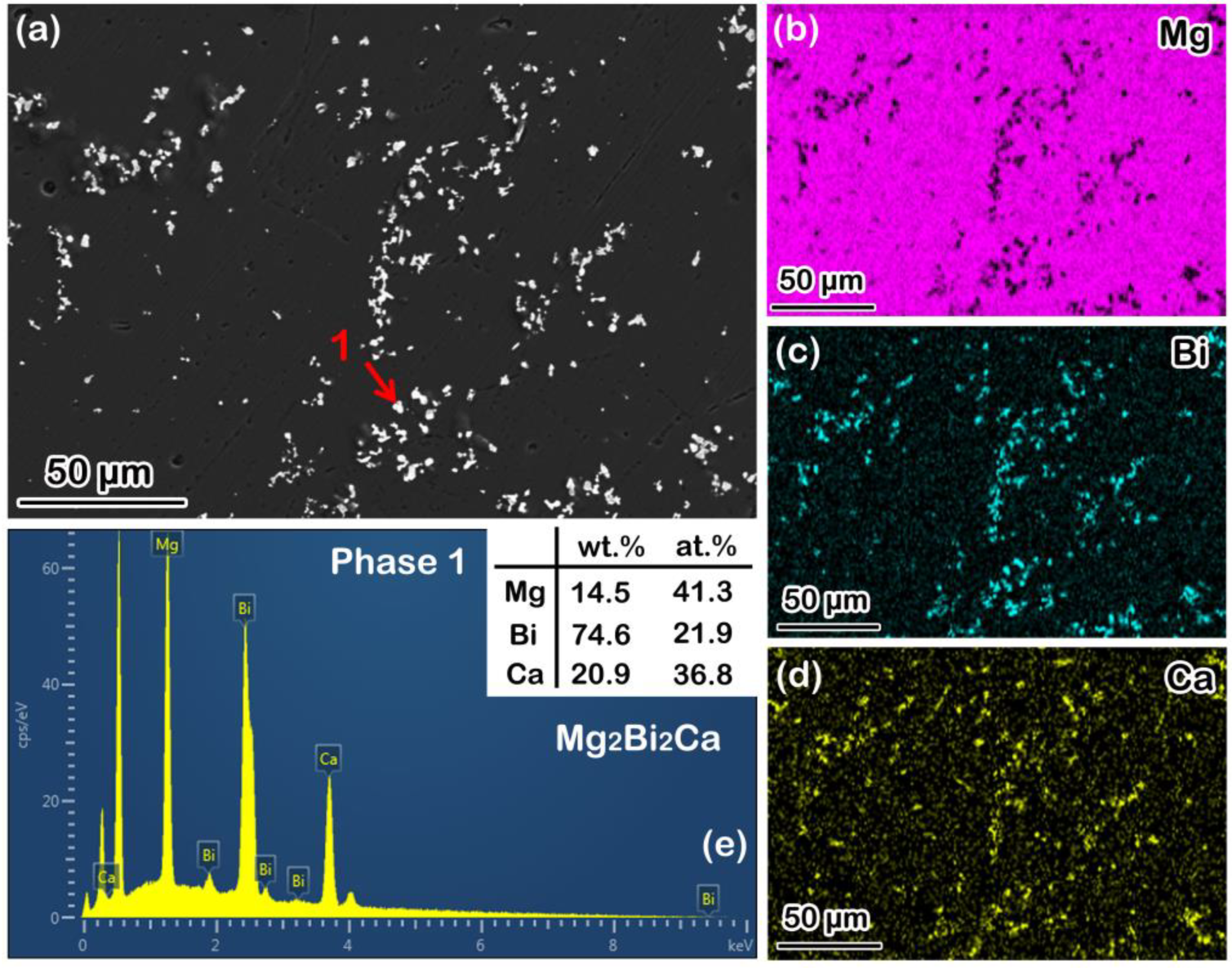




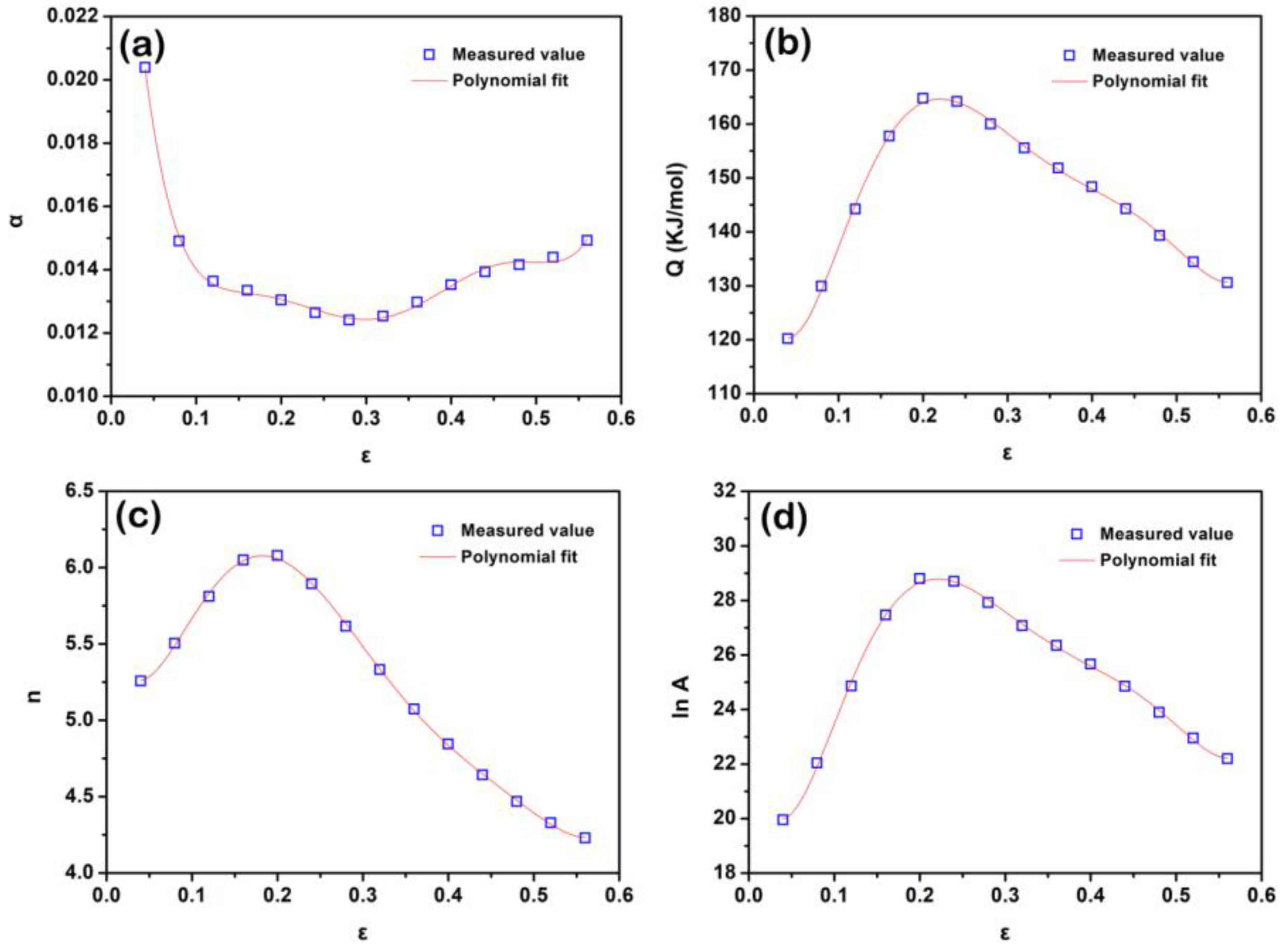

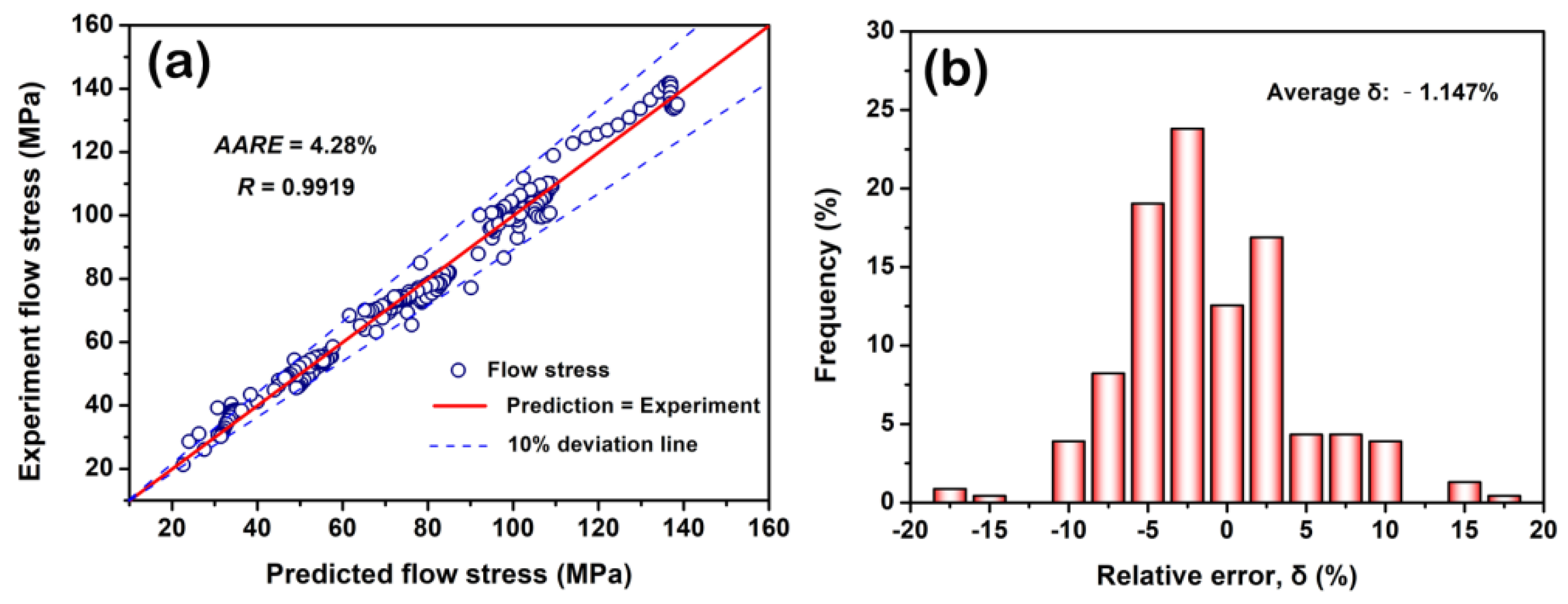
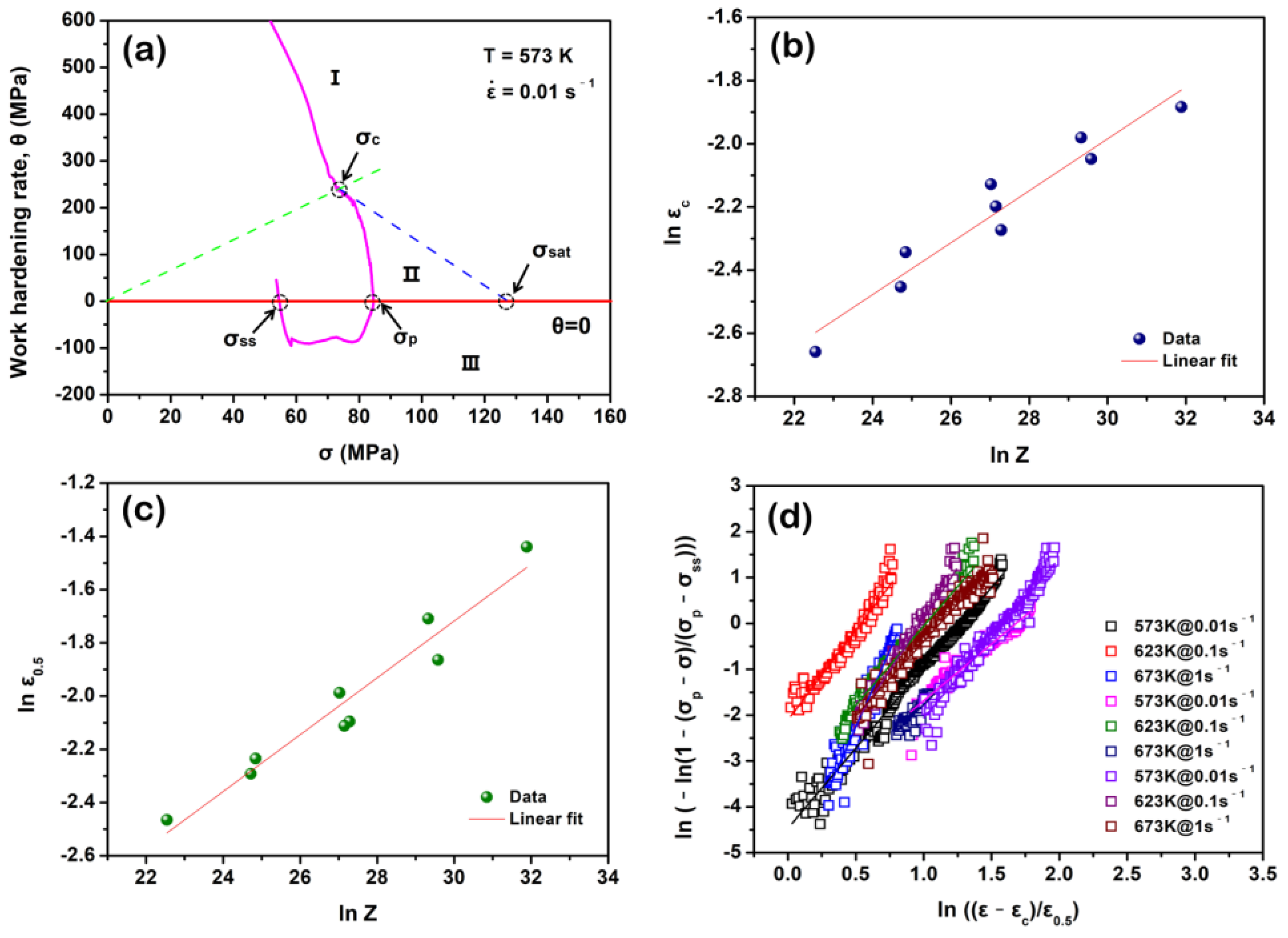

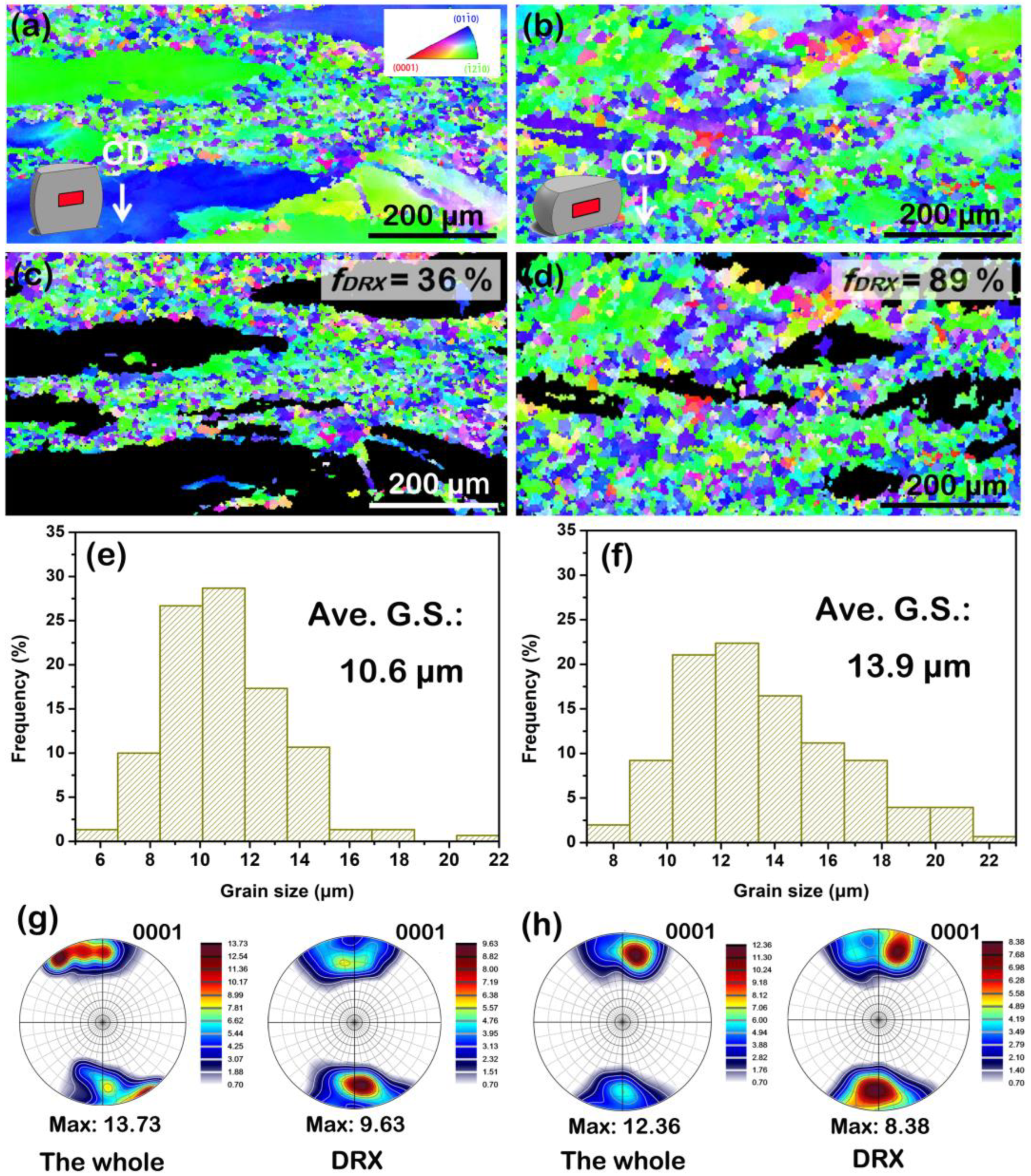

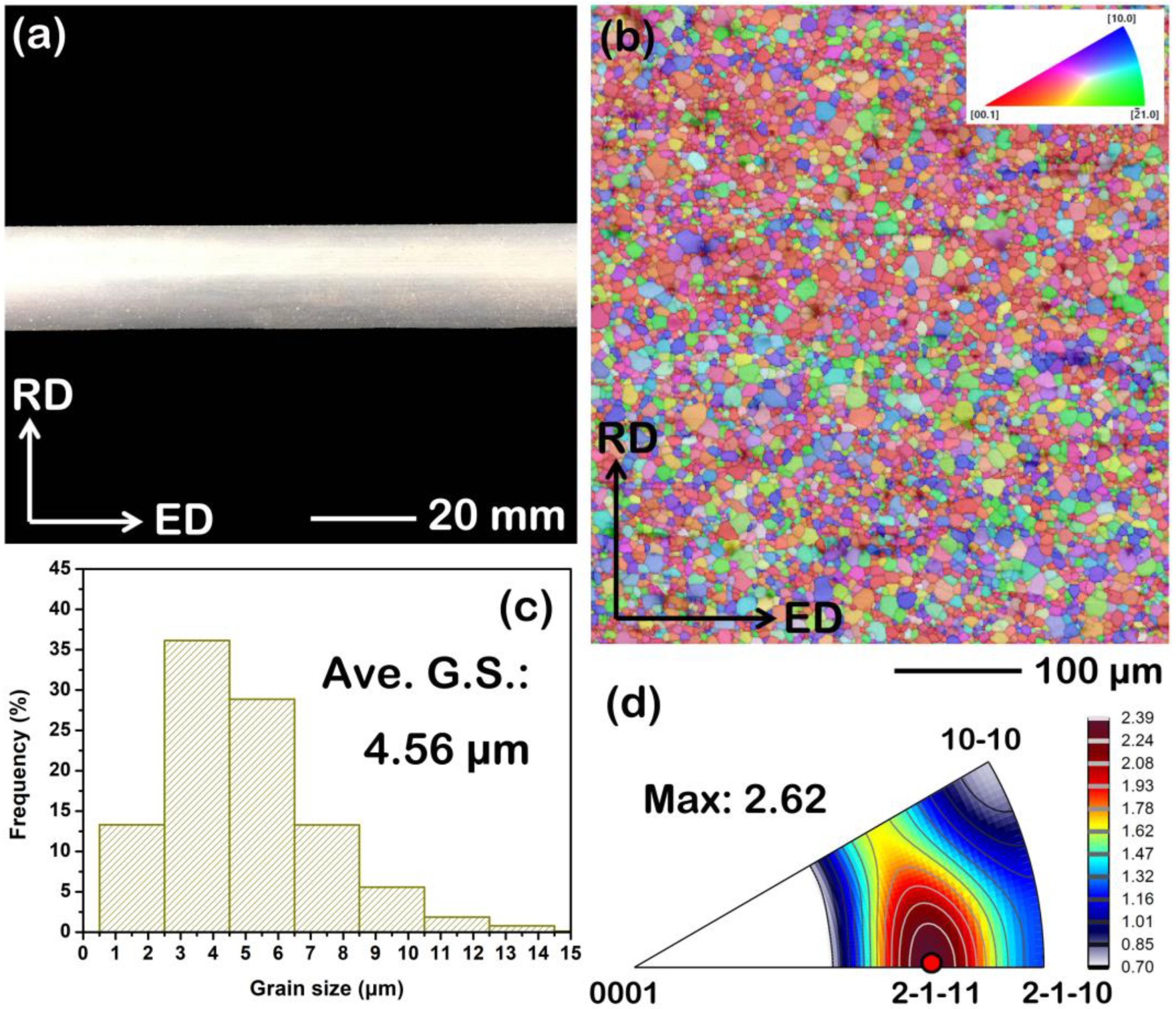
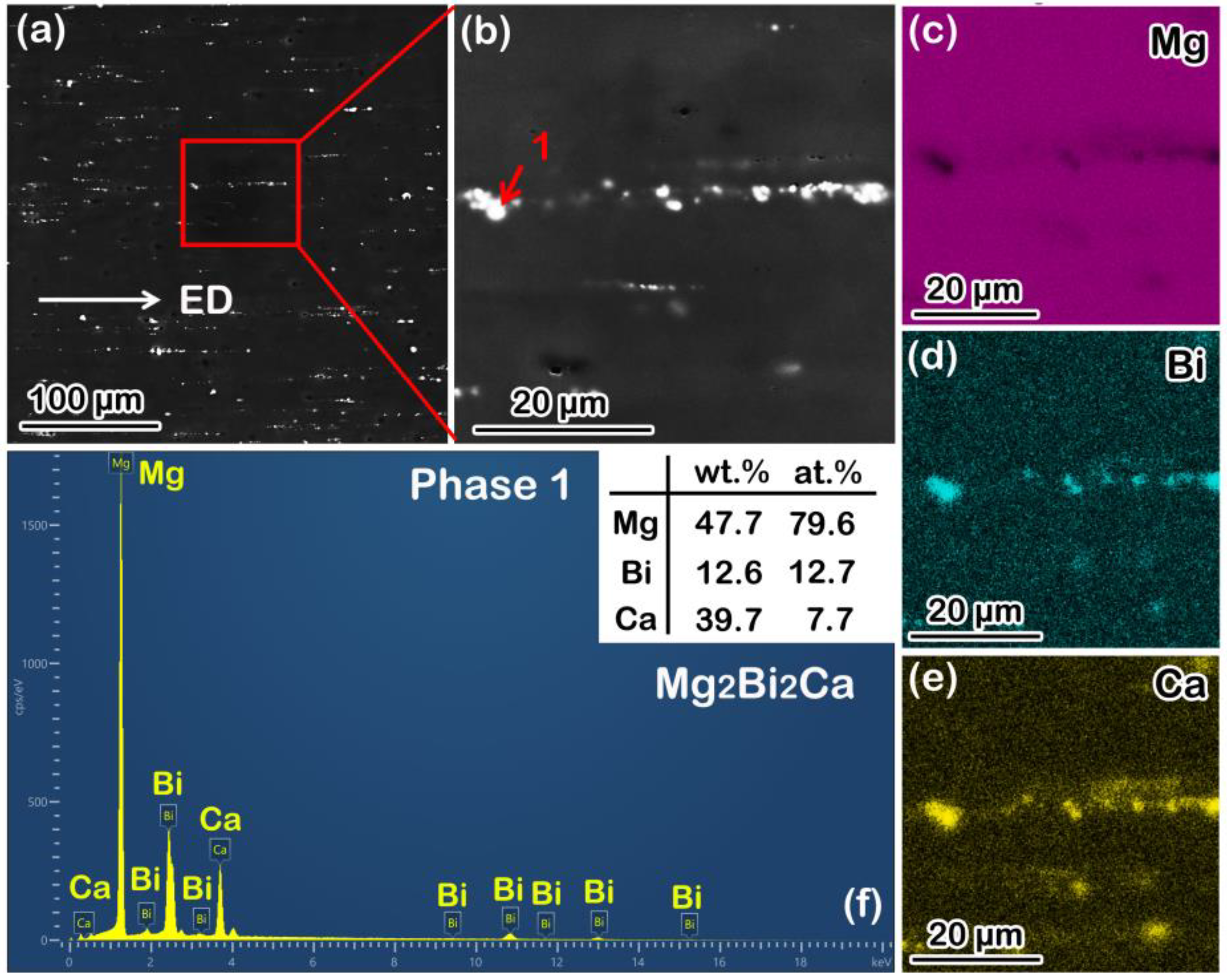

| α | Q | n | lnA |
|---|---|---|---|
| α0 = 0.0343 | Q0 = 138.6302 | n0 = 5.6236 | InA0 = 22.9529 |
| α1 = −0.5172 | Q1 = −1049.6868 | n1 = −22.5556 | InA1 = −181.8720 |
| α2 = 5.1075 | Q2 = 18,785.7115 | n2 = 432.5720 | InA2 = 3422.1192 |
| α3 = −25.5741 | Q3 = −110,944.6683 | n3 = −2667.7302 | InA3 = −20,427.6000 |
| α4 = 67.i.e60 | Q4 = 303,759.5483 | n4 = 7324.5991 | InA4 = 56,149.0301 |
| α5 = −88.9583 | Q5 = −398,898.1624 | n5 = −9495.3504 | InA5 = −73,886.5001 |
| α6 = 46.1098 | Q6 = 203,225.5371 | n6 = 4756.1032 | InA6 = 37,684.4203 |
| Strain Rate (s−1) | Deformation Temperature (K) | |||
|---|---|---|---|---|
| 573 | 623 | 673 | ||
| σc (MPa) | 0.01 | 67.5 | 42.9 | 31.9 |
| 0.1 | 93.9 | 56.4 | 50.3 | |
| 1 | 125.8 | 78.4 | 72.8 | |
| σ0.5 (MPa) | 0.01 | 69.1 | 47.2 | 32.0 |
| 0.1 | 102.8 | 67.5 | 51.2 | |
| 1 | 130.7 | 88.8 | 74.8 | |
| εc | 0.01 | 0.103 | 0.086 | 0.070 |
| 0.1 | 0.129 | 0.119 | 0.096 | |
| 1 | 0.152 | 0.138 | 0.111 | |
| ε0.5 | 0.01 | 0.123 | 0.101 | 0.085 |
| 0.1 | 0.155 | 0.137 | 0.107 | |
| 1 | 0.237 | 0.181 | 0.121 | |
Publisher’s Note: MDPI stays neutral with regard to jurisdictional claims in published maps and institutional affiliations. |
© 2022 by the authors. Licensee MDPI, Basel, Switzerland. This article is an open access article distributed under the terms and conditions of the Creative Commons Attribution (CC BY) license (https://creativecommons.org/licenses/by/4.0/).
Share and Cite
Wang, Q.; Wang, L.; Zhai, H.; Chen, Y.; Chen, S. Establishment of Constitutive Model and Analysis of Dynamic Recrystallization Kinetics of Mg-Bi-Ca Alloy during Hot Deformation. Materials 2022, 15, 7986. https://doi.org/10.3390/ma15227986
Wang Q, Wang L, Zhai H, Chen Y, Chen S. Establishment of Constitutive Model and Analysis of Dynamic Recrystallization Kinetics of Mg-Bi-Ca Alloy during Hot Deformation. Materials. 2022; 15(22):7986. https://doi.org/10.3390/ma15227986
Chicago/Turabian StyleWang, Qinghang, Li Wang, Haowei Zhai, Yang Chen, and Shuai Chen. 2022. "Establishment of Constitutive Model and Analysis of Dynamic Recrystallization Kinetics of Mg-Bi-Ca Alloy during Hot Deformation" Materials 15, no. 22: 7986. https://doi.org/10.3390/ma15227986





